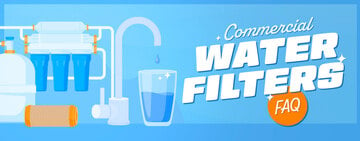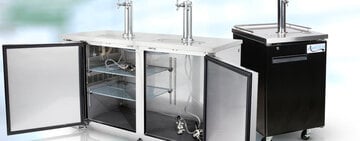
As an operator, you put so much time and energy into researching commercial kitchen equipment, deciding whether to purchase it new or used, and what the best deal on shipping is, so it can be easy to overlook one essential element - what to do when it arrives. To help the installation of your equipment go smoothly, we've created a checklist you can use to stay organized and efficient when your kitchen equipment arrives.
Shop All Restaurant EquipmentClick below for a downloadable restaurant equipment installation checklist:
Download our Restaurant Equipment Installation Checklist PDF
1. Plan for Delivery
Before scheduling the delivery, consider the time required for installation and decide what time of day will work best for you. If you order through Webstaurant, you can select "Call Before Delivery" on our checkout page and you will receive a call from the carrier company to schedule a delivery window. We highly recommend taking advantage of this option. Mistimed or poorly organized equipment deliveries can result in food delivery and equipment installation crews competing for parking, staging areas, or dock and corridor access. If you ordered the equipment online, it must be delivered to the restaurant before installation by a third party. Make sure someone is ready and properly equipped to receive it. You should also make certain that secure staging is available, and you should check the packaging for any obvious signs of damage.
Many pieces of equipment require a dock or truck liftgate to remove them from a delivery vehicle. A key component of efficient installation is to ensure that such logistic tools are available, or, if they are not, then alternative arrangements need to be made. Discuss any questions you have about a liftgate with either the company shipping the equipment or the dealer you bought the equipment from.
2. Ensure Easy Building Access
The entrance door/delivery door must be large enough to accommodate the equipment shipment. If the equipment must be placed on an elevator to reach its final installation point, the elevator must have enough capacity to handle the equipment. That requires a measurement of the elevator (inside volume + the size of the door opening) as well as a measurement of the equipment that is going to be placed in the elevator. Make sure that the elevator has sufficient weight capacity to safely handle the item. Every elevator is licensed for a specific weight limit that cannot be exceeded.
If a new piece of equipment must make its way through the door and down a series of hallways before it reaches its final installation point, then it is important to measure the door openings and hallways. They must be large enough for the equipment to easily pass through them. You should also make sure that the hallways are wide enough, with a minimum number of bends and curves that could potentially impede the movement of the equipment.
3. Confirm Utility Requirements
Having the wrong utilities is the number one culprit for improperly operating equipment in the food service industry. Some things you need to be aware of concerning utilities and new equipment installation include:
- Voltage Requirements - Make sure that the voltage and phase of the equipment being delivered match what your food service establishment provides. The AMP requirements of the equipment being installed match that of the service that is in the building. Confirm the wiring and plug supplied with the equipment are both long enough and compatible with the electrical outlet (if a plug is being used).
- Gas Requirements - Confirm the gas requirements of the equipment being delivered match the natural gas or propane available at your facility. Make sure that there is sufficient gas pressure. Gas pressure, which equates to the volume of gas reaching the piece of equipment, will have a direct bearing on the effectiveness and efficiency of the equipment. We all know altitude affects baking, but elevation also has a major impact on equipment performance. At any significant elevation above sea level, the gas orifice found on all pieces of gas equipment must be calibrated and set to the elevation at which the piece of equipment is going to be installed.

4. Check Water Availability and Quality
Many pieces of equipment (such as steamers, steam-jacketed kettles, combi-ovens, coffee urns, dishwashers, etc.) require water for their basic operation. A key component of any proper installation for these pieces of equipment is to ensure that there is a water source close to, or preferably, at the point of equipment installation. Restaurant water waste can rack up major costs, so consider ways you can reduce your water use when purchasing water-reliant equipment. Having a water connection close to or at the point of equipment installation is just one water consideration. Ensuring there is sufficient water pressure and enough water available to meet the demand is just as important. For instance, water pressure is essential for proper warewashing, while certain steam cooking equipment requires a minimum quantity of water for its use.
Water quality is important; in a hard water area with equipment like a steam kettle, a water softener may be required. Temperature may also be important, so decide ahead of time whether the equipment should be connected to the hot or cold water systems. Some equipment can be connected to the hot water system to reduce recovery times and speed up operation. If a piece of equipment such as a steamer, combi-oven, etc., is being installed, you also need to make sure a proper drain is present. This drain must be located where the new piece of equipment will be installed or must be easily accessible. If you have to make a drainage connection, know ahead of time whether PVC or copper pipe is required and plan accordingly.
5. Check Hood Requirements
If the new piece of equipment is going to be installed under a hood, you must make sure that the depth of the hood is large enough to properly accommodate it. You will need a minimum of 12" from the front edge of the cooking equipment to the front edge of the hood. Check out our resource on commercial kitchen hood code requirements for total compliance. When new and/or additional pieces of equipment are added to an existing hood system, confirm there is sufficient airflow (CFMs) through the hood. This allows for the proper operation of both the new piece of equipment and the original pieces of equipment under the hood. Failure to do so often escalates other closely related problems.
6. Review Specifications and Regulations
Check the manufacturer's specification sheet for any special installation requirements being recommended or required for proper installation. A "spec sheet" can generally be acquired through the manufacturer's website. If you purchase from WebstaurantStore, you can find equipment Specsheets in the Resources and Downloads section of the product's page.
Understanding local foodservice regulations and codes is essential for installing commercial kitchen equipment. Familiarize yourself with local requirements such as the necessity of a hood or ventilation system and specific certifications for equipment. Conducting research beforehand can help prevent potential issues and comply with the law.
7. Remove Old Equipment
You can't get the new equipment installed until the old equipment has been removed from the premises. Make sure you remove the old items before the new equipment is delivered. If you know that the new equipment is going to be delayed, or if it comes into your facility damaged or missing parts, you may need to have the existing (old) equipment moved to one side but in a place where it can be easily reinstalled if these problems continue.

8. Set up a Level Mounting Surface
Most pieces of equipment must be installed on a level surface to work properly. If the new piece of equipment is installed on a table, then this problem does not normally manifest itself. If the new piece of equipment is installed on the floor of a commercial kitchen, then one must ensure it is done on a level surface, or that it has adjustable legs/feet so it can be properly leveled. This problem is often found in a kitchen that has many floor drains as the floorplan is laid out so all water hitting the floor flows to these drains.
9. Fill out the Warranty Card
Locate the manufacturer's warranty card and complete it accurately. If needed, seek assistance from the dealer to fill out all the information correctly. It is crucial to promptly return the warranty card to the manufacturer. The equipment warranty plays a significant role in the overall value of the purchased asset and should be handled with care and attention.
10. Follow Instruction Manual
With all of these steps completed, you're ready to install your new piece of restaurant equipment. Follow the manufacturer's instructions to install the equipment. Hire a third party if necessary. After the equipment is installed, properly dispose of all construction debris and packing materials. Confirm that packing materials have been removed from centers, burners, and small spaces in the equipment. This is vital before operating your new equipment.
11. Equipment Demonstration
If you are properly trained in how the equipment is to be used and cared for, then you should arrange to do a complete and thorough demonstration of the equipment for staff members who will be using that piece of equipment. If you are not familiar with its use, then arrange for a representative of the manufacturer to give a thorough demonstration as soon as possible. And, if you need to use actual food products for start-up, testing, and demonstrations, make sure you have an adequate supply of product(s) available.
Webstaurant offers installation services in select metro areas for select equipment purchased through our site. Taking advantage of this service reduces the stress of implementing a new piece of equipment into your commercial kitchen. Whether this assistance is available to you or not, using our commercial kitchen installation checklist will ensure a seamless process.





